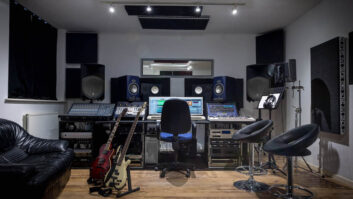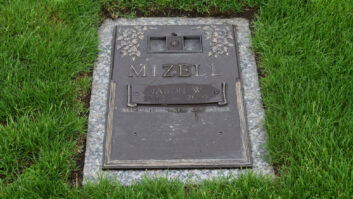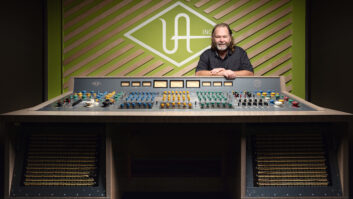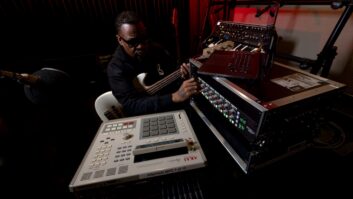The Schoeps DSP-4P ($3,850) is described by the company as a digital
microphone processor for the PolarFlex system. What does the PolarFlex
system do, you might ask? The PolarFlex system presents an interesting
proposition: Two pairs of vertically coincident omni/figure-8 or
back-to-back cardioid capsules may be used in combination to create two
virtual microphones. Also, the user may, by combining the patterns,
create a pair of virtual microphones capable of any pattern between,
and including, the omni and figure-8 patterns.
In addition, the frequency response of the combined pairs can be
collectively altered past the confines normally associated with any
particular mic pattern by creating highly adjustable crossover points,
which provide a multiplicity of single-band, dual-band or 3-band
equalization circuits.
While Schoeps does not mandate that its microphones be used for the
PolarFlex system, the company does suggest the use of small-diameter condenser microphones. Schoeps suggests the CCM 2S
omni, CCM 8 figure-8, CCM 4V or CMXY 4V cardioids from the Compact Series, or CMC 62S
omni, CMC 68 figure-8 or CMC 64V cardioid from the Standard Series.
Schoeps was kind enough to provide pairs of CCM 8 and CCM 2S mics and
mounting rigs along with the DSP-4P. (The total cost of this rig would
be $8,765, including all mics, cables and the DSP-4P.)
AROUND BACK
The Schoeps DSP-4P microphone processor is housed in a compact chassis
(8.6×3.5×9.6 inches) that weighs six pounds. The 24-bit digital I/Os
are optimized for high-quality digital audio and use Motorola 56009
DSP. The AD/DA converters are from AKM. On the back panel, there are
two rows of XLR connectors. The top row, all 24-bit digital,
consists of two AES/EBU inputs (four channels of digital audio), two
AES/EBU outputs (four unprocessed digital audio channels) and one
AES/EBU processed stereo output. Internally, all audio signal
processing is handled by fourth-order Infinite Impulse Response (IIR)
filters used with 56-bit DSP accumulators.
In addition to being a digital audio input, the first XLR is also
used as the master digital input to synchronize the DSP-4P’s internal
A/D converters to an external clock when the analog inputs are used.
Multiple DSP-4P units can be operated together in master/slave
configurations. The second XLR also functions as the slave input,
switching the DSP-4P to Digital Input mode when a digital signal is
detected.
The bottom row of analog XLRs consists of two 5-pin female XLR
connectors that can be used either as mic inputs for the two pairs of
mics or as four analog line inputs. The 48VDC phantom power delivered
to these input XLRs cannot be defeated. To prevent the phantom power from damaging the output circuitry
of any attached devices, Schoeps suggests using isolation transformers
when interfacing line-level equipment. Analog outputs 1 and 2 are 5-pin
XLRs that carry the four channels of unprocessed audio. Analog output 3
carries a 5-pin processed stereo output.
Also on the back panel are toggle switches to select 44.1/48kHz
operation and pads to accommodate +20dB mic (for 10mV/PA condenser mics) or +10dB line
inputs. Mics that are more sensitive than 10 mV/Pa may also use the
line input. An IEC standard power receptacle is used, and the power
supply can be operated at 110 to 120 VAC or 220 to 240 VAC. Power
consumption is 15 VA.
AROUND FRONT
The front panel has five multifunctioning knobs; a two-position switch
determines their usage. The PATTERN/CR.-FREQ. position allows the three
upper knobs to be adjusted to create three different polar patterns: one for lows, one for mids and one
for highs. Patterns are selectable in 11 steps, from omni to figure-8.
Each of the three patterns can also be turned off, which is the
equivalent of introducing an 18dB/octave cut across the particular
frequencies established by the crossover frequencies.
The fourth and fifth knobs are used to move the two crossover
frequencies, thereby creating 1, 2 or 3-band operation. The crossover
frequencies are adjustable in 1/3-octave steps from 100 to 1k Hz and 1
to 10 kHz.
In the GAIN/dB MODE position, EQ is achieved by cutting each of the
three parts of the frequency spectrum a maximum of 5.5 dB in 0.5dB
steps. Although EQ is entirely cut-based, one band can be raised by
lowering the others and boosting the Overall Gain control. Both analog
and digital input signals can be raised in 12 3dB steps to a maximum of
33 dB with this control. The fifth knob is used to configure the DSP-4P
for Mode A (omni/figure-8 microphones) or Mode B (back-to-back
cardioids).
A three LED display indicates -24dB, -12dB and -3dB levels, and
suggests that the -3dB light be barely lit to prevent distortion. I
tested it. They are right; even moderate -3dB illumination results in
some nasty-sounding audio. Once you have achieved a particular setup,
you can save it by using the Down/Up/Store buttons. The 10 presets only
include directional characteristics and crossover frequencies. Level
settings for each band and overall gain are not saved.
The DSP-4’s four 24-bit AD/DA converters operate at 44.1 and 48 kHz,
and are externally clockable for sample rates from 25 to 50 kHz. The
idea here is that both virtual mic pairs can be recorded to four analog
or digital destinations, or both, to be retrieved later for virtual
processing. Of course, the DSP-4P can also be used simply as four
mic/line inputs with 24-bit A/D converters.
During the recording process, you point the pairs of microphones so
that the front end of each omni/figure-8 or back-to-back cardioid is
aimed at the intended sound source. You might put the sound source
somewhere between the two arrays, or you might position the arrays at a
center point and record the audio as a surround environment. While a
discrete 4-channel recording is occurring, you can use the DSP-4P’s
controls through its processed outputs to experiment.
The quality of the space itself becomes very important when using
this technique. If your studio or intended recording site has any nasty
little secrets, then the DSP-4P will make them apparent. My own
experiments with the system were made with several acoustic guitar
sessions and one with didgeridoo. I put the players between the pairs
of mics and recorded the instruments in a typical stereo space.
Changing the parameters changed the size of the space and how the
instruments sat in it. In one case, a refrigerator on another floor
created low frequencies (almost inaudible to the ear) that were very
apparent through the Schoeps microphones. Adjustments to both the
patterns and EQ reduced the LF to a tolerable level.
I kept wishing that a classical string or jazz quartet would call me
for a session at a nice concert hall while I had the system available.
Unfortunately, that didn’t happen. Even though you can get four
discrete channels of audio, I think it bears mentioning that any
recording with multiple musicians would best be done with players who
understand the importance of mixing by dynamic “give and
take.” If everyone turns it up to 11 and wails, that’s exactly
what you’ll get.
The documentation is fairly easy to understand, and I found the
DSP-4P straightforward to operate. I did have a few moments of
confusion while trying to remember whether I needed to be in PATTERN
CR. FREQ. or GAIN/dB MODE positions, but they faded over time as I
became more familiar with the device.
WHY?
I see the appeal here for engineers and producers who may be leaning
toward more minimal miking techniques as a way of eliminating
multi-microphone phasing issues, and who have run into restrictions
from frequency response or mic patterns. Similar to Mid/Side recording,
this technique allows you to capture the performance for future
manipulations. Sure, you’d take up four tracks where you might have
only used two, but if you had the tracks, you’d probably have put up a
couple of extra “just ’cause” mics, anyway.
I have not talked to anyone in the U.S. yet who has begun thinking
about microphones and soundfields in this manner. Mid/Side recording is
used in the U.S. to record location ambience for feature films, because
at the time of recording, no one knows whether the audio will be
married to a close-up, mid- or wide shot. Mid/Side is also valuable
because it allows those decisions to be made during the post-production
process.
In France more so than in the U.S., Foley is recorded as Mid/Side.
Immediately, the Schoeps PolarFlex system offers more variations than
the standard two-microphone Mid/Side method. I would not be surprised
to find the DSP-4P in the sound department of the French film industry
or in classical concert recordings before it receives acceptance in the
U.S.
CONCLUDING
Where pattern and EQ have become both independent and important issues,
the Schoeps DSP-4P is positioned to be a solution rather than a
“just because we can” concept box. The DSP-4P demands that
you use your ears; because of this, not everyone will appreciate its
need or use, particularly those who employ a set-and-forget approach to
recording. In a worst-case scenario, you still get four high-quality
preamps and 24-bit AD/DA converters at about $950 a channel. By
themselves, even without the flexibility offered by the PolarFlex
controls, that’s still a good deal.
Schoeps, www.schoeps.de







